We receive an alert during the weekend to let us know, literally: 'surf's up'. So today's bus trip is to the fishing village of Nazaré, now renowned for big-wave surfing. Though not included in Saramago's Journey, it is included in Rick Steves' Tours, so I am happy to make another day trip – even though I am not particularly interested in surfing. Over a decade in the Bay Area, we never went to Mavericks, for example, but then I don't think there was standard bus service. Today, Rede Expressos orders up an extra autocarro for the morning run.
The bus sets us down at the southern end of the old Praia (beach) neighborhood, so we walk first west to the ocean, then north towards the high-ground known as Sitio. The big waves are along the Praia do Norte, on the other side. To the east, above Praia, is the neighborhood of Pederneira, which is less travelled by tourists, but may offer good views over the town and the shore.
We reach the ocean, make our turn, and our gaze is stopped by the perfectly vertical wall of the cliff. The escarpment cuts the foam and mist to our left; one can imagine that diagonal edge piercing the ocean's floor and plowing up the sea. Past lands end and above the ocean's horizon, we see dark, compact hills set on the line. The hills grow frosty with spray, then collapse against the outcrops - it's the surf. Along with video, the audio soon follows – the hiss and hammer of the water's rhythmic rush. Both the cliff and the waves are beyond expectation.
As the beach walk starts uphill, we turn east into the alleys to find the funicular station, a silvery glass gap in the weathered streetscape. At the top, the lift delivers us to the Largo de Nossa Senhora da Nazaré. Where I was expecting a wide, cliff-top plaza and distant beach views, we find a regular town square, arranged around the solid, twin-spires of the Santuário de Nossa Senhora de Nazaré. The keepers by their shops and street vendors fill the perimeter, compressing the scale further; obviously, they also got the surf alert.
Just to one side of the Largo is the Ermida da Memória, a tiny stone capela covered with tiles, and with a short stairway down to a cramped shrine. In the wall of the lower level there is a teeny, hazy window that looks back over the beach. The chapel marks the grotto (hermitage) involved in the 'Miracle of Nazaré', which is summarized by a pamphlet distributed at the Santuário:
On September 14th, 1182, the knight Dom Fuas Roupinho, governor of Porto de Mós, was out hunting in the woods near the coast covered by heavy fog, when he saw a deer which he immediately began chasing. The deer ran towards the top of a cliff and the knight in the midst of the fog was cut off from his companions. When he realized he was on the edge of the cliff, he recognized where he was. He was next to a small grotto where, some time ago, he had found a statue of the Virgin Mary on an altar. Thus he prayed out loud – Our Lady Help Me! And all of a sudden, the horse miraculously stopped at the end of the rocky point suspended over the void, the Point of the Miracle, saving the rider and his mount from a long drop that would certainly cause their death.
The 'Point of the Miracle' is just to the right of the chapel, but it is marked with a cross and the prohibition zona interdita, as the rock does truly overhang the cliff's edge. While the sign is serious enough, the cross adds a level of authority. I suspect it is no longer structurally viable, though I did see some nonbelievers walk to the parapet. It's a day of chances.
We follow the crowds through the plaza. The roads turn into grassy foot paths, and devolve into scoured, stoney surfaces trailing down to the lighthouse. There are a few green tufts that make good lookouts, and we can finally take in some action. I check the wave forecast for Nazaré, and it says 5.5m, less than twenty feet, but those waves look like fifty (WSL later reports forty-five feet). We stare alertly at each shadowy swell looking for the seam of white that signals a surfer.
I go as far down to the lighthouse as my view over the increasing crowd allows. The power cables don't help the sight lines, either. These are the hard core. They are deeply focused, with an announcer calling the action, eliciting gasps and applause. I wonder about the applause – does it help? Can the riders hear anything beyond the thunder of the surf, the buzz from the jet-skis? Adding to the commotion, there are drones whizzing around, but are soon comically drowned-out by fighter jet passes from the Força Aérea Portuguesa. That cannot help a surfer's concentration.
I am able to grab just a few videos and attach them below. In the first video, watch left of the emergency van, just at the start of the clip, you'll see a surfer trying to outrun the crest. In the second video, look right above the light at the 0:36 mark, and watch the surfer ride the face of the wave down, and safely out at about 0:53 (with apologies for the play by play). Also check: World Surfing League Nazaré Tow Surfing Challenge (Praia do Norte, Nazaré; recap, images, and videos from SurferToday).
The interior sparkles with gold embellishments. The aisles abruptly end where Doric portico terminates, so the chapels are like Baroque kiosks, standing in the nave. A gold-trimmed, coffered dome is framed by barrel vaults within the transepts. The ends of the transepts are brimming with azulejos panels depicting old testament stories (the images of David and Goliath, Jonah and the Whale are particularly good).
The church attendant sits underneath the Jonah panel, happily explaining the stories to his guests. For a euro each, he lets us enter the porcelana passage that leads to the sacristy. We enter beneath a delicate iron stair structure. The stairs take us up to a pair of skinny portals that work, restaurant-like, in or out. There is a low landing space, then a doorway out to a platform above the church altar. There we find the Virgem Negra, the small figurine that saved Dom Fuas and his leaping steed. The legend states:
According to the old parchment the statue must have been venerated since the beginning of Christianity in Nazareth, Holy Land. In the fifth century the Greek monk Ciriaco brought it to Spain, to the monastery of Cauliniana, near Mérida, where it remained until 711, the year of the battle of Guadalete.
(T)he defeated king, Roderic … asked for shelter at the monastery of Cauliniana. When he requested one of the friars, Romano, to hear him in confession … the friar suggested they flee together to the Atlantic Coast, taking with them some relics and the holy sculpture of the Virgin of Nazareth.
So the name Nazaré comes from Nazareth, or whatever was the ancient version of that city's name.
Leaving the church, we cross the Largo and follow the railing wall to the Ladeira do Sitio, and follow that down to the passages of Praia. Old ladies with baskets of beans and nuts offer samples. We continue out of the Praia, to the Escadaria da Pedralva, taking us to what I hope will be a nice sunset in Pederneira. But it is growing misty again, and there is a clamorous construction site at the Miradouro. A shame that an enjoyable walk come to an unsatisfying end.
Donna needs a break before we walk down. I have a moment to reflect, and now looking at my photos, the images look surprisingly appealing. Maybe my disappointment is unwarranted.
So, we descend the Escadaria to Praia, once more into the alleys. We find them filled with the honey-shades of sunset, which finally breaks the mist and the cloud deck. We pass post card stands and surf shops. Tent cards in doorways advertise hostels and quartos.
We have time to grab a snack before our return bus to Lisboa. As we collect our thoughts, and scrub through our photos, I learn that a surfer, Alex Botelho, is in the hospital after he was caught in whitewater while being towed – his jet ski apparently tossed over and struck him. As one of the few Portuguese in the competition, I hope he knew enough to invoke the help of Nossa Senhora. Our best wishes to Alex for a speedy recovery.
This awesome landscape certainly inspires risk: waves, cliffs, wipe-outs, and miracles. The seaside villages settled on these beaches and hills are well adapted to its dangers and its bounty, and this may be at the heart of Portugal's saudade. These masters of surf and their armies of fans bring unique opportunities. Nazaré is all about its customs and legends, as well as its industrious residents.

UPDATE (September 10, 2020): The Guiness World Records certifies that we witnessed a true world record: largest wave surfed – unlimited (female).

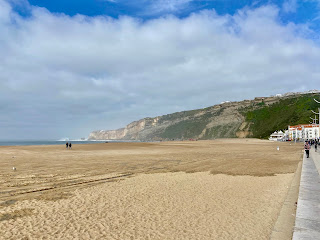


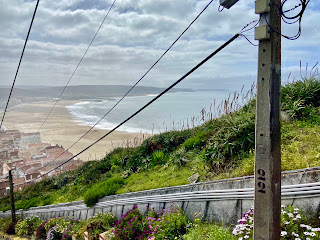
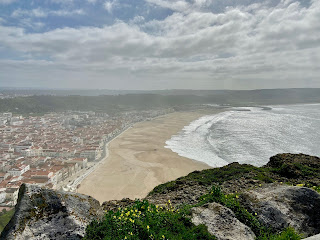





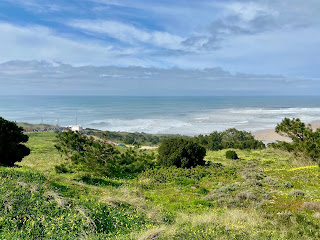













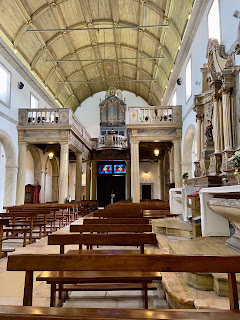




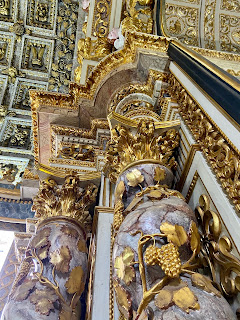





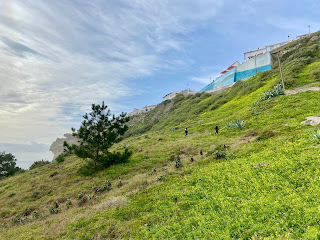










1 comment:
Winston, thank you for this incredibly detailed account of your day by the surf. We feel as though we were there with you, through your photos/videos and descriptions. Such a lovely day for you and Donna. We are so lucky to see the world of Portugal through your skilled eye. Aproveite seu dia - Mary and Beverly
Post a Comment